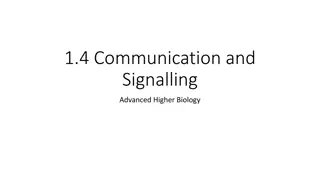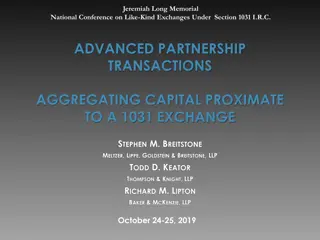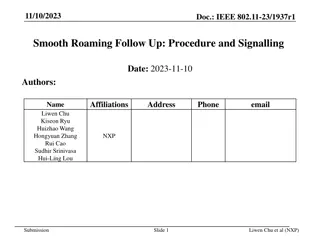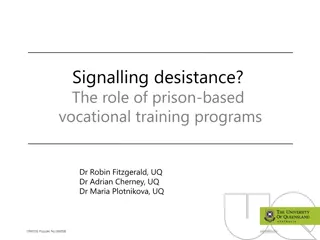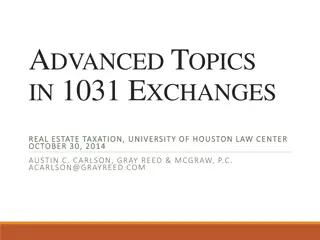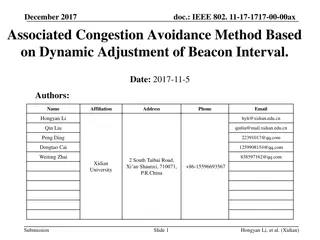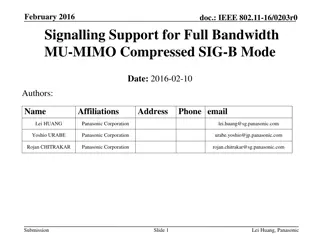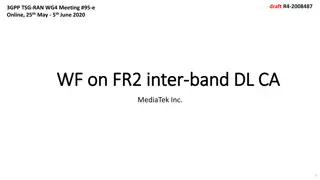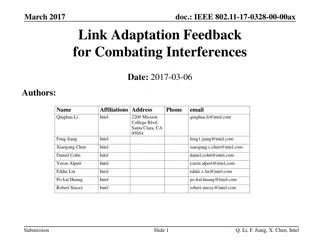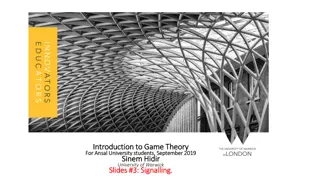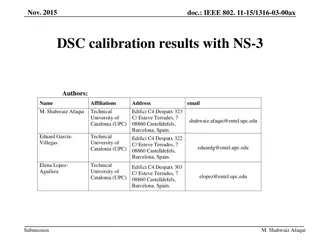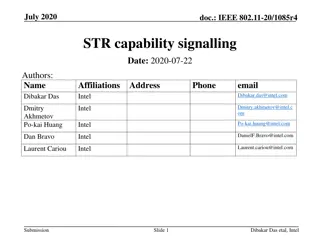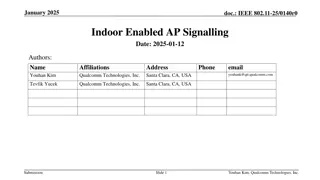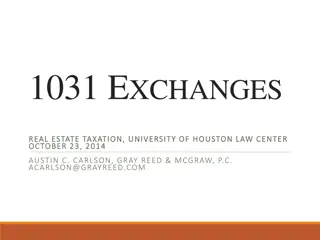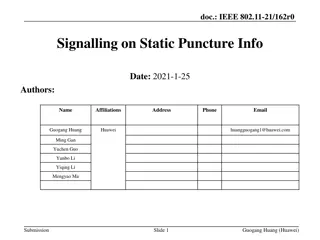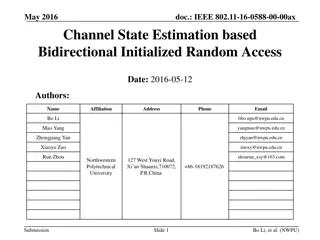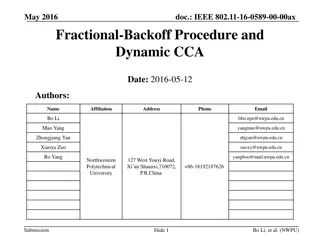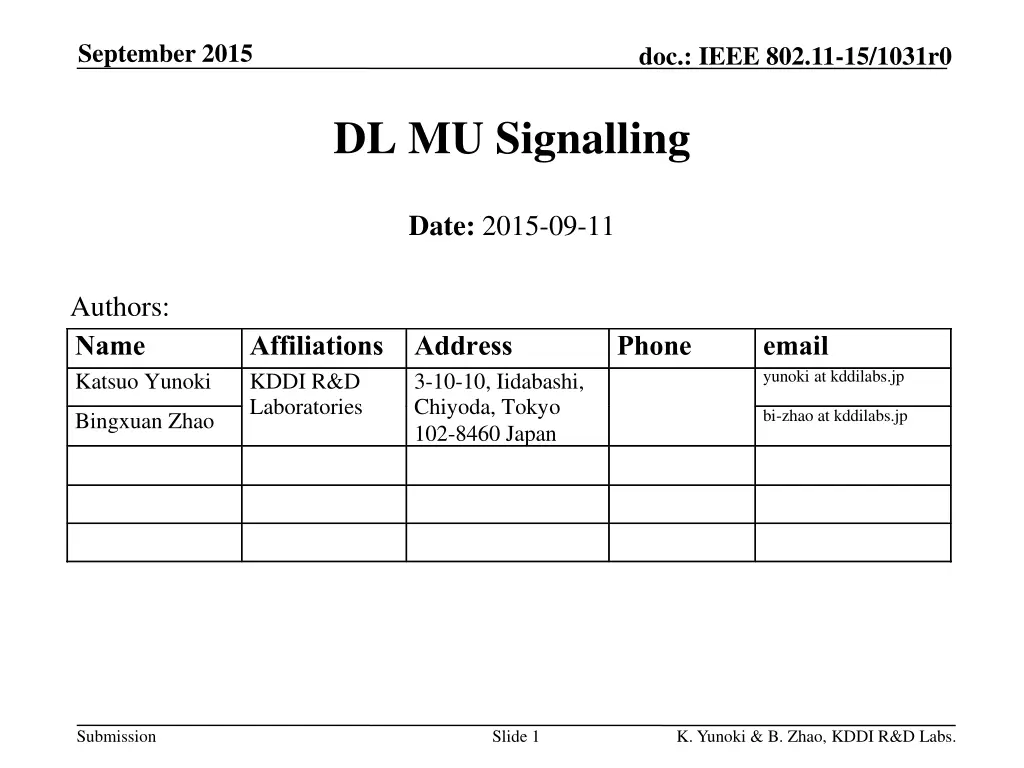
IEEE 802.11-15/1031r0 DL MU Signalling September 2015
Explore the combination of MU-MIMO and OFDMA within 20 MHz as proposed in the IEEE document, highlighting the results of a straw poll and potential solutions discussed by K. Yunoki and B. Zhao from KDDI R&D Labs in September 2015.
Download Presentation

Please find below an Image/Link to download the presentation.
The content on the website is provided AS IS for your information and personal use only. It may not be sold, licensed, or shared on other websites without obtaining consent from the author. If you encounter any issues during the download, it is possible that the publisher has removed the file from their server.
You are allowed to download the files provided on this website for personal or commercial use, subject to the condition that they are used lawfully. All files are the property of their respective owners.
The content on the website is provided AS IS for your information and personal use only. It may not be sold, licensed, or shared on other websites without obtaining consent from the author.
E N D
Presentation Transcript
September 2015 doc.: IEEE 802.11-15/1031r0 DL MU Signalling Date: 2015-09-11 Authors: Name Katsuo Yunoki Affiliations Address KDDI R&D Laboratories Phone email yunoki at kddilabs.jp 3-10-10, Iidabashi, Chiyoda, Tokyo 102-8460 Japan bi-zhao at kddilabs.jp Bingxuan Zhao Submission Slide 1 K. Yunoki & B. Zhao, KDDI R&D Labs.
September 2015 doc.: IEEE 802.11-15/1031r0 Background Straw poll #5 in [1] asked the following question: Do you think the combination of MU-MIMO and OFDMA within 20 MHz should be allowed? The result was Y/N/A=84/0/38 This submission shows a base concept for combination of MU-MIMO and OFDMA. Submission Slide 2 K. Yunoki & B. Zhao, KDDI R&D Labs.
September 2015 doc.: IEEE 802.11-15/1031r0 DL MU-MIMO Signalling (11ac) MU[0]=STA0 MU[1]=STA1 MU[2]=STA2 MU[3]=none VHT SIG-A1 expresses DL MU-MIMO coordination. (1) BW indicates PPDU bandwidth. - - It s common for all users. (2) Group ID indicates user assignment and position of NSTS field which an assigned user should refer to for this MU PPDU reception. - Separately, Group ID Management frame identifies membership status and user positions[MU(0)~MU(3)] for DL MU-MIMO. (3) NSTS indicates number of space-time streams for each user. <VHT SIG-A1 format> (1) (2) (3) 80M 2 1 1 0 <e.g.> MU[0]= STA0 2STS MU[1]= STA1 1STS 1STS 80MBW AP MU[2]= STA2 Red letters are assumptions for the example figure below. Submission Slide 3 K. Yunoki & B. Zhao, KDDI R&D Labs.
September 2015 doc.: IEEE 802.11-15/1031r0 Assumption #1 for 11ax DL MU transmission (1) The same bandwidth will be used for all space-time streams. (2) Each space-time stream can be shared and divided for multiple users. (OFDMA) (3) A STA will belong to a station group using the same set of space-time streams. Any STAs will not belong to plural sets of space-time streams. (2) (3) (1) STA01 STA02 STA03 STS1 (3) (2) STS2 STA11 AP RU STS3 80MHzBW STA12 RU STS4 (2) STA21 STA22 STA23 STA24 (3) Submission Slide 4 K. Yunoki & B. Zhao, KDDI R&D Labs.
September 2015 doc.: IEEE 802.11-15/1031r0 Possible Solution #1 Format of VHT SIG-A1 could be reused for HE DL MU transmission for the assumption #1. A STA group will be assigned for a set of space-time streams for DL OFDMA. The groups for sets of space-time streams will be identified in Group ID. The requirements for Group ID should be discussed. MU[0]=STA group 0 MU[1]=STA group 1 MU[2]=STA group 2 MU[3]=none <11ax> <11ac> MU[0]=STA0 MU[1]=STA1 MU[2]=STA2 MU[3]=none 80M 80M 2 1 1 0 2 1 1 0 No change Group ID expression is a subject. Are the current 6 bits sufficient to express? No change Submission Slide 5 K. Yunoki & B. Zhao, KDDI R&D Labs.
September 2015 doc.: IEEE 802.11-15/1031r0 Possible Solution #1 (+ ) When just OFDMA is applied without DL MU-MIMO, just a STA group is expressed in Group ID, <e.g. 1> or, only a STA group has NSTS value. <e.g. 2> other different ways may be possible. MU[0]=STA group 0 MU[1]=none MU[2]=none MU[3]=none MU[0]=STA group 0 MU[1]=STA group 1 MU[2]=STA group 2 MU[3]=none <e.g. 1> <e.g. 2> OR 2 0 0 0 2 ? ? ? no NSTS values What are these fields for? Submission Slide 6 K. Yunoki & B. Zhao, KDDI R&D Labs.
September 2015 doc.: IEEE 802.11-15/1031r0 Assumption #2 for 11ax DL MU transmission (4) Segmentation (RU allocation) for each set of space-time streams could be different from other ones. 52 tones (This figure is 20MHzBW based.) (4) 52 tones 26 tones 106 tones STS1 (4) 106 tones STS2 RUs STS3 20MHzBW 26 tones AP STS4 106 tones (4) 52 tones 26 tones 26 tones 26 tones K. Yunoki & B. Zhao, KDDI R&D Labs. 106 tones Submission Slide 7
September 2015 doc.: IEEE 802.11-15/1031r0 Possible Solution #2 for all users (omni-directional) per set of space-time streams (directional) HE- SIG-B HE- STF Data L-Preamble HE-SIG-A HE-LTF Segmentation (RU allocation) for each set of space-time streams could be expressed in common part of HE SIG-B. They can be different among sets of space-time streams. Indication of RU location for each STA is also a subject. Submission Slide 8 K. Yunoki & B. Zhao, KDDI R&D Labs.
September 2015 doc.: IEEE 802.11-15/1031r0 Summary Reuse of VHT SIG-A1 format was proposed for 11ax DL MU transmission It is required to study the following issues: Group ID expression for combination with OFDMA Indication of RU location for each STA Detailed HE SIG-A format Submission Slide 9 K. Yunoki & B. Zhao, KDDI R&D Labs.
September 2015 doc.: IEEE 802.11-15/1031r0 Straw Poll Do you agree to add the following text to SFD? The amendment shall define Group ID expression to identify stations multiplexed in DL MU PPDU with MU-MIMO, OFDMA or combined usage of both. Y/N/A = Submission Slide 10 K. Yunoki & B. Zhao, KDDI R&D Labs.
September 2015 doc.: IEEE 802.11-15/1031r0 References [1] 11-15/854r2, DL OFDMA Signalling [2] IEEE Std. 802.11ac-2013 Submission Slide 11 K. Yunoki & B. Zhao, KDDI R&D Labs.


